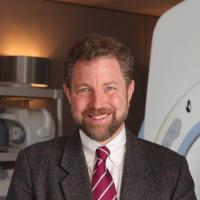Professor of Biomedical Engineering and Radiology, Director of Magnetic Resonance Imaging; Principal Investigator at Columbia's Zuckerman Institute
There are plenty of compelling reasons to push MRI to be more powerful, but that’s one facet of advancing the field. Another is delivering it to the world.

Last year, J. Thomas Vaughan joined Columbia as director of Magnetic Resonance Research, a new University-wide position. A pioneer in the field with 45 patents to his name, Vaughan designs and builds the MRI systems that produce high-resolution images of anatomical, metabolic and physiological systems and functions. His inventions, usually licensed by the biotech and medical industries, are found in most MRI systems.
“He has designed some of the key technology for MRI that enabled extremely high-resolution images of brain structure and function at high field strengths,” said Biomedical Engineering Chair Andrew Laine, who was involved in the faculty search that brought Vaughan — known as Tommy — here from the University of Minnesota. “Tommy’s arrival is already changing the landscape of the MR community throughout Columbia.”
MRI, invented in 1977, produces highly detailed images by scanning the body using strong magnetic fields, radio waves and field gradients, a measure of the rate of change in the electric field of an atomic nucleus that is generated by an electronic charge. The stronger the magnet, the better the image quality, resolution and speed.
Vaughan is both a principal investigator at the Mortimer B. Zuckerman Mind Brain Behavior Institute and a professor of biomedical engineering at the School of Engineering, as well as a professor of radiology at Columbia University Medical Center. “He has reached out to both clinical and basic science researchers and begun to formulate program project grants that will provide new resources and infrastructure to Columbia,” Laine said.
Vaughan is working on the logistics of moving a 9.4 Tesla magnetic resonance system to Columbia. These systems are built with the highest field strength magnet ever used to image humans. It is not an easy relocation; the magnet alone weighs 50 tons, and the shield around it is comprised of 350 tons of welded steel plate. Only four such systems exist.
“We’re not just engineers who will be testing equipment and building new toys,” Vaughan said. “We’re working hand in glove with the application scientists.”
The intensity of Vaughan’s research is offset by his easy-going demeanor, which is especially evident when explaining the complexities of MRI to non-experts. Biking from his office on the Morningside campus to an interview at the Zuckerman Institute on the Manhattanville campus, Vaughan could, with his helmet and backpack, easily be mistaken for one of his graduate students.
As an undergraduate at Auburn University, Vaughan could not decide on a major, so he took time off to cycle through 57 countries. He returned two years later to complete two BS degrees, in electrical engineering and in biology. After graduation, he joined Texas Instruments in Dallas to work in radar and simultaneously attended graduate school at the University of Texas Southwestern, finishing in 1984.
“The general consensus then was that MRI would never find a clinical application,” he said. “The first machines that I built or worked on were seen as exotic research instruments.”
Since he had taken organic chemistry and radar, Vaughan decided to take nuclear magnetic resonance as a required elective. The university had just received one of the first 1.8 Tesla whole body magnets, but it had no system to support it. A chance meeting with the professor who worked with the magnet led to a collaboration.
“There’s very little difference between a radar set and an MR system, so it didn’t take long for us to put two and two together,” Vaughan said. He engineered the back-end for the MRI system, which allowed him to turn his master’s degree into a PhD.
Although widely used in some countries, MRI is not available to 90 percent of the world’s population. Vaughan and a colleague from the University of Minnesota, Michael Garwood, developed a portable, remotely supportable system. In 2014, they received a National Institutes of Health BRAIN Initiative grant to demonstrate the feasibility of this system.
“We threw out everything we knew about MRI and started to reinvent it with new constraints,” Vaughan said. It is lighter and more compact than traditional systems and uses new imaging physics. Data is transmitted by laptop to a satellite link in the cloud, eliminating a bulky console system. The scientists plan to collaborate with governments and industry to introduce the system.
Here at Columbia, “I still have blue sky overhead, and that’s what I really need and like because I can dream as big as the world — that’s exactly what we’re doing here,” Vaughan said. “There are plenty of compelling reasons to push MRI to be more powerful, but that’s one facet of advancing the field. Another is delivering it to the world.”
This piece first appeared on Columbia News.
Member (1989–Present), Chair of MR Safety Study Group (2013–Present)
Geethanath S,
J Magn Reson Imaging.2019 Jun
Eryaman Y, Kobayashi N, Moen S, Aman J, Grant A, , Molnar G, Park MC, Vitek J, Adriany G, Ugurbil K, Harel N
Neuroimage.2019 Jan 1
Eryaman Y, Lagore RL, Ertürk MA, Utecht L, Zhang P, Torrado-Carvajal A, Türk EA, DelaBarre L, Metzger GJ, Adriany G, Uğurbil K,
Magn Reson Med.2018 Jan
Eryaman Y, Zhang P, Utecht L, Kose K, Lagore RL, DelaBarre L, Kulesa J, Eberly LE, Adriany G, Iles TL, Iaizzo PA, , Ugurbil K
Magn Reson Med.2018 Jan
Sohn SM, Gopinath A,
IEEE Trans Microw Theory Tech.2016 Oct